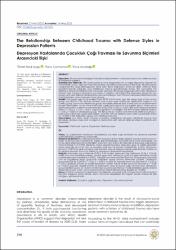| dc.contributor.author | Uygur, Ömer Faruk | |
| dc.contributor.author | Tuman, Taha Can | |
| dc.contributor.author | Hurşitoğlu, Onur | |
| dc.date.accessioned | 2023-08-24T12:40:27Z | |
| dc.date.available | 2023-08-24T12:40:27Z | |
| dc.date.issued | 2022 | en_US |
| dc.identifier.citation | Uygur, Ö. F., Tuman, T. C. ve Hurşitoğlu, O. (2022). The relationship between childhood trauma with defense styles in depression patients. Journal of General Medicine, 32(3), 298-303. https://dx.doi.org/10.54005/geneltip.1091974 | en_US |
| dc.identifier.issn | 2602-3741 | |
| dc.identifier.uri | https://dx.doi.org/10.54005/geneltip.1091974 | |
| dc.identifier.uri | https://hdl.handle.net/20.500.12511/11360 | |
| dc.description.abstract | Objective: We aimed to investigate the relationship between childhood trauma with defense styles in depression patients. Materials and Methods: Fifty-seven patients were diagnosed with a major depressive disorder for the first time, and 51 age-sex-matched healthy volunteers participated in this study. All participants completed the socio-demographic data form, Beck Depression Inventory (BDI), Defense Style Questionnaire-40 (DSQ-40), and Childhood Trauma Questionnaire (CTQ). We compared the defensive style and childhood trauma scores between the group diagnosed with major depressive disorder and the group of healthy volunteers. In addition, we divided the depression group into two groups (with and without childhood trauma) according to the CTQ and compared defensive styles and depression scores between these groups. Results: The mean age of the patients was 30.93 ± 8.43 years, and the mean age of the control group was 30.94 ± 7.05. Mature defense style scores were statistically significantly higher in the control group than in the depression group. Immature defense style scores and all sub-dimensions except dissociation scores were statistically significantly higher in the patient group. There was a significant positive correlation between BDI and CTQ (r = 0.56; p < 0.001), BDI and immature defense styles (r = 0.52; p < 0.001), and a negative significant correlation BDI with mature defense styles (r = -0.38; p < 0.001) in depression group. The BDI score (p < 0.001) and immature defense styles (p = 0.03) were statistically significantly higher, and the mature defense styles were substantially lower (p = 0.009) in the depression group with childhood trauma. Conclusions: Our study results showed a positive relationship between childhood trauma and immature defense styles and a negative association with mature defense styles in patients with depression. | en_US |
| dc.description.abstract | Amaç: Bu çalışmanda depresyon hastalarında çocukluk çağı travmaları ile savunma biçimleri arasındaki ilişkiyi araştırmayı amaçladık. Materyal ve Metod: Bu çalışmaya depresyonlu 57 hasta ve 51 yaş-cinsiyet uyumlu sağlıklı gönüllü katıldı. Tüm katılımcılar Sosyodemografik Formu, Beck Depresyon Envanteri (BDE), Savunma Biçimleri Testi-40 (SBT-40) ve Çocukluk Travma Anketi'ni (ÇÇTÖ) doldurmuştur. İki grup arasında savunma tarzı ve çocukluk çağı travma skorlarını karşılaştırdık. Ayrıca depresyon grubunda CTQ'ya göre çocukluk çağı travması olan ve olmayan gruplar arasında savunma stilleri ve depresyon düzeyleri araştırıldı. Bulgular: Hastaların yaş ortalaması 30.93 ± 8.43, kontrol grubunun yaş ortalaması 30.94 ± 7.05 idi. Olgun savunma biçimleri puanları, kontrol grubunda depresyon grubuna göre istatistiksel olarak anlamlı derecede yüksekti. İmmatür savunma biçimleri puanları, dissosiasyon dışındaki tüm alt boyutlarda hasta grubunda istatistiksel olarak anlamlı derecede yüksekti. BDE puanı ile ÇÇTÖ (r = 0,560; p < 0.001), olgunlaşmamış savunma biçimleri (r = 0,527; p < 0.001) arasında anlamlı bir pozitif korelasyon ve olgun savunma biçimleri ile negatif anlamlı bir korelasyon vardı. BDE puanı (p < 0.001) ve olgunlaşmamış savunma biçimleri (p = 0,013) çocukluk çağı travması grubunda çocukluk çağı travması olmayan gruba göre istatistiksel olarak anlamlı derecede yüksekti. Sonuç: Çalışma sonuçlarımız, çocukluk çağı travması ile depresyon hastalarında azalmış olgun savunma biçimleri ve artmış immatür savunma biçimleri arasında sağlıklı kontrol grubuna göre anlamlı bir ilişki olduğunu göstermektedir. | en_US |
| dc.language.iso | eng | en_US |
| dc.publisher | Selcuk University School of Medicine | en_US |
| dc.rights | info:eu-repo/semantics/openAccess | en_US |
| dc.subject | Childhood Trauma | en_US |
| dc.subject | Depression | en_US |
| dc.subject | Defense Styles | en_US |
| dc.subject | Çocukluk Çağı Travması | en_US |
| dc.subject | Depresyon | en_US |
| dc.subject | Savunma Biçimleri | en_US |
| dc.title | The relationship between childhood trauma with defense styles in depression patients | en_US |
| dc.title.alternative | Depresyon hastalarında çocukluk çağı travması ile savunma biçimleri arasındaki ilişki | en_US |
| dc.type | article | en_US |
| dc.relation.ispartof | Journal of General Medicine | en_US |
| dc.department | İstanbul Medipol Üniversitesi, Tıp Fakültesi, Dahili Tıp Bilimleri Bölümü, Ruh Sağlığı ve Hastalıkları Ana Bilim Dalı | en_US |
| dc.authorid | 0000-0001-8401-4992 | en_US |
| dc.identifier.volume | 32 | en_US |
| dc.identifier.issue | 3 | en_US |
| dc.identifier.startpage | 298 | en_US |
| dc.identifier.endpage | 303 | en_US |
| dc.relation.publicationcategory | Makale - Ulusal Hakemli Dergi - Kurum Öğretim Elemanı | en_US |
| dc.identifier.doi | 10.54005/geneltip.1091974 | en_US |
| dc.institutionauthor | Tuman, Taha Can | |
| dc.identifier.trdizinid | 1107954 | en_US |


















